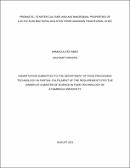| dc.description.abstract | Ghee is one of the major fermented foods consumed in Uganda despite the fact that it is largely
produced traditionally raising issues of quality control and assurance. This study investigated the
bacterial diversity of traditional ghee obtained from different regions of Uganda in an effort to
determine the technological properties of its dominant lactic acid bacterial (LAB) flora. A total
of nine samples were purchased in original packaging, from Buganda (2), Bunyoro (2), Teso (2)
& Ankole (2) regions including a control sample and subjected to microbial analysis using
conventional and molecular protocols to obtain an overview of the microbial diversity of these
different ghee varieties in order to focus on the dominant LAB flora.
Traditional ghee from Teso was contaminated with coliforms and E. coli, but the latter were not
isolated which could be due to failure to collect these organisms from random colonies selected
from the media plates during isolation. The species identified using 16S rDNA sequence analysis
include Enterococcus faecium (22 isolates, 30%), Lactobacillus plantarum (20 isolates, 28%),
Lactobacillus rhamnosus (11 isolates, 15%), Enterococcus hirae (11 isolates, 15%),
Enterococcus faecalis (2 isolates, 3%) and Bacillus cereus (2 isolates, 3%), with Lactobacillus
spp. being the dominant (31 isolates, 43%) genus detected in all samples. MEGA X analysis of
the 16S rDNA PCR gel images gave separate clusters for each of L. plantarum and L.
rhamnosus; each of the clusters was heterogeneous and contained isolates from different subregions
of Uganda highlighting possible genetic relationship between these Lactobacillus
isolates.
Since L. rhamnosus is preferred to L. plantarum for inclusion in fermented dairy products due to
its probiotic properties, three (03) L. rhamnosus isolates were evaluated for potential probiotic
properties, antimicrobial activity against Staphylococcus aureus, Escherichia coli, and
Salmonella enterica, and growth and acid production profiles in milk, in order to establish their
prospects for application as probiotics, bio-preservatives and/or starter cultures in milk and other
fermented foods. Each of the tested isolates exhibited good acid tolerance at the exposure of
0.7% ox bile at 30ºC for 0, 3, 6 and 9 h and remained viable (3 log reduction) after 3 h of
exposure at pH 3, did not produce biogenic amines and had high level of auto-aggregation at 24
h. However, all the isolates were sensitive to bile salts implying that they may not survive the
xii
entire gut transit. On agar overlay assays, each of the L. rhamnosus isolates had antimicrobial
activity against at all the tested indicator bacteria at 30oC, 24 h and 37oC, 24 h for LAB isolates
and indicator bacterial strains, respectively. In the disc diffusion assays, only neutralized cellfree
supernatants for each of the Lactobacillus isolates lost antimicrobial activity, implying that
activity was due to acid production.
Subsequently, two L. rhamnosus isolates were studied further for growth kinetics and acid
production prospects in UHT milk model to determine their starter culture potential. All the L.
rhamnosus isolates had similar growth patterns in milk attaining 8-10 log cfu/ml at 48 h.
However, the isolates had low acid production capacity leading to a pH decrease from 6.89-6.92
to 4.89-5.04 after 48 h of fermentation. Acid production was growth-dependent and maximum
acidification occurred at exponential phase (8-24 h).
It was concluded that L. rhamnosus isolated from Ugandan traditional ghee does not have
prospects for application as a starter culture due to its low acidification capability. However,
these organisms have some favorable probiotic and antimicrobial properties which could be
exploited commercially. Further research should investigate the aroma compounds which could
be produced by these organisms in milk and other fermented foods when grown alone and in coculture
with L. plantarum, and/or yeasts and moulds which were also detected in the traditional
Ugandan ghee. Further studies should focus on stabilization of the lactic acid bacterial isolates
against bile | en_US |

